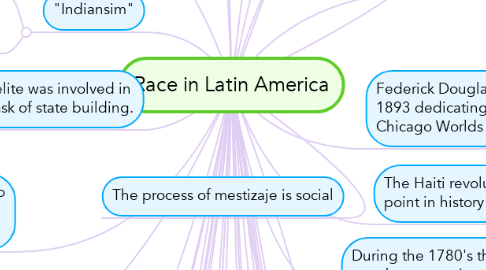Race in Latin America
저자: Stephanie Gonzalez


1. No one believed in the theory of biological inferiority, therefore abolitionists only tried to refute racist doctrines
2. Brazilians were forced to focus on race not slavery
3. Brazil had its own racist political movement.
4. At the end of the 19th century, Hispanic America entered a period of economic growth.
4.1. exports, massive public works, railroads, and new factories were all changes to becoming more modernized.
5. Between 1880- 1930, Hispanic Americans were influenced by Darwinism
6. Racial theriores were embraced by Hispanic American elite until 1920.
7. Argentina had almost completed one century of indeependence
7.1. it had fulfilled the dream of its elite.
8. Cuba obtained independence from Spain in 1898
9. The solution to Argentina's modernization problems were immigration and education.
10. The whitening of Argentina was a fast process
10.1. in 1869, Indians took up five percent of the population. By 1895, they took only 0.7%
11. Indians were considered the most challenging enemy of Argentinian population
11.1. By 1890, many of Argentina's Indians had been killed or enslaved.
12. By the 1880's, blacks and Indians became minorities and immigration became a social issue.
13. The Constitution of 1901 gave nonwhites equally and universal male suffrage
14. The immigration law imposed on Cuba in 1902, prohibited Chinese immigration.
15. Creole elite decided to make Argentina and Cuba a white nation after their independence
16. Upwardly mobile individuals were whitened
17. The process of mestizaje is social
18. "An Indian is one who feels that he belongs to an indigenous community"
18.1. Indians are socially defined
19. Indigenuta
19.1. The Indian contribution to the Revolution had been anonymous
20. Indigenismo came more easily to Mexico elites than American elites.
20.1. Indigenismo represented another non-indian formulation of the Indian problem
20.2. It was a white/mestizo construct
20.3. it was a enlightened and sympathetic formulation
20.4. Indigenismo coincided with the social upheaval of the revolution.
21. Porfirian elite was involved in parallel task of state building.
22. "Indiansim"
22.1. Denied the very imperative of integration
22.2. On various occasions it was characterized by a romanticization of Indian history and culture.
23. The revolution gave a fresh incentive to the process of nation-building
24. The mestizo became the ideological symbol of the new regime
25. The third idigenismo reproduced many of the racist assumptions of the "Westernism"
25.1. firmly opposed
25.2. continued to operate within racist paradigm
26. Racism was an intellectual encumbrance that couldn't be shaken off
26.1. it stood as testimony to the continuities linking Porfirian and revolutionary thoughts
27. Mexico's Chinese population was subjected to oppression which led to large explosions in 1931.
28. Where Indians remain, racism remains.
28.1. Government cannot eliminate racism in Mexico that it can in Britain or the US
29. Federick Douglass delivered a speech on January 2, 1893 dedicating the Haitain pavilion of the Chicago Worlds Fair
29.1. Douglass helped plan the exhibits of the pavilion, which he called "A city set upon a hill."
30. Douglass was born as a slave on 1818
30.1. He became the most prominent black spokesman and statesman in the New World.
30.2. He stated that "Haiti was "The original pioneer emancipator of the 19th Century.
30.2.1. it was Haiti's goal to teach the world of the dangers of slavery and the latent powers and capability of the black race.
